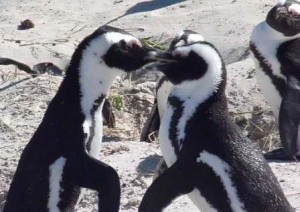
African Penguins kissing at Foxy Beach, South Africa.
You might be tempted to think that these little cuties took a wrong turn at the last iceberg. After all, don’t penguins belong in Antarctica? It’s true that all species of penguins live in the southern hemisphere, but many people are surprised to discover that one of the species lives in South Africa. It’s called the African Penguin. (I’ll bet you can figure out why they’re called that.)
Check out this video I took while visiting Foxy Beach, just a short walk from my house. Have you ever seen anything so cute in your whole life?!
Now stand up. Go ahead. I’ll wait…..
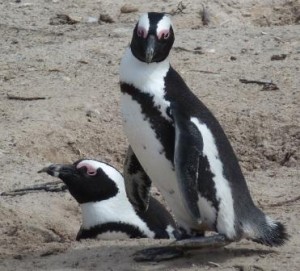
A penguin digs a nest in the sand. Penguins lay eggs, just like other birds.
Now look down at the distance from the floor to your knees. That’s about how tall an African Penguin is – much smaller than the Emperor Penguins from Antarctica. However, they have much in common. The most important is that their “wings” are really flippers, so they can’t fly like other birds, but they are FANTASTIC swimmers. The slowest African Penguin can swim faster than the fastest swimmer in your class. That’s because its life depends on it!
Penguins have some serious predators that are always looking for a quick McPenguin lunch! Fur seals and sharks are the African Penguin’s biggest threat while in the ocean. On land, they have to be on the watch for cats, dogs, and mongooses. Even seagulls can be a danger because they’ll try to steal their eggs. People also used to take their eggs to eat, but this endangered species is now protected, so people must leave them alone.
The African Penguin has some way cool adaptations. I know you’ll be jealous, but I’ll tell you about them anyway. Its eyes can focus in and out of water, and it can see well in low light, so it can even swim at night. Its nickname is, “Owl of the Sea”. Wouldn’t be fun to be able to do that?!
That’s not all. It has a very strong sharp beak to bite into fish. But it also uses it to protect itself, so never bite a penguin. When it bites you back, it will really hurt! The fleshy spines on its tongue help it hold onto slippery fish and squid. When a penguin drinks the sea water and eats fish, it takes in a lot of salt. That’s OK. Its body separates out the salt so the penguin can blow it out its nose. Boys, if you could do THAT, I’m sure the girls would be very impressed!
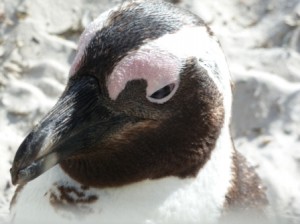
A penguin’s black, white, and pink coloring is an adaptation that has helped the species to survive.
I think the coolest adaptation is the penguin’s colorings: pink, white, and black. See those pink areas above its eyes? They’re temperature regulators. The hotter the penguin gets, the more blood that flows through these glands. When the blood is cooled by being close to the surface of the skin, the bird cools down. It’s belly is white. When it’s swimming, a shark won’t see it from below. When Mr. Shark looks up, he will just see the white sunshine hitting the water. The penguin is black on top, so when a seal looks down into the depths of the ocean it won’t notice the penguin swimming below. Don’t you love that?! No wonder penguin species have survived for millions of years!
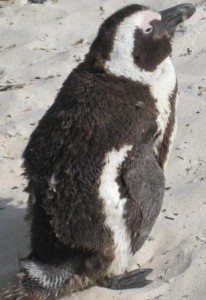
Each year, when a penguin molts, it loses its waterproof feathers. It must wait on the shore until new feathers grow in.
Once a year, sometime between September to November, penguins molt. That is, their old feathers fall out and they’re replaced with new feathers. (Just like a snake sheds its skin.) During this time, the penguins can’t swim, which means there is no way for them to catch fish. To help themselves through this, they fatten up beforehand. They then come to my beach, Foxy Beach (and a few other beaches around South Africa), and molt for three to four weeks. They eat nothing during this time. When their new feathers are in, they’re ready to head out in the ocean again (and they’re hungry!).
The sad part is, that the African Penguin almost became extinct. Local fishermen were catching so many fish, there weren’t enough left for the penguins, so many of them died. Ocean pollution and diseases in the water also decreased their population. On top of that, much of their beach habitat had been destroyed by people over the years who had their own uses for the beach.
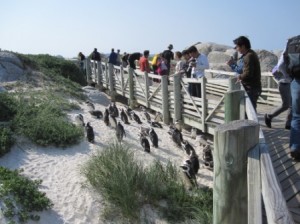
Penguins and people can be in the same area without disturbing each other.
The good news is that some people recognized the problem and set up laws to protect these cute will birds of the ocean. They stopped the fishing in the area, and created laws to protect the birds’ habitat. They created a safe area so birds and people can live together in harmony. Although the African Penguin is still on the “endangered” list, I hope that, with the help of caring South Africans, their species will be able to survive.
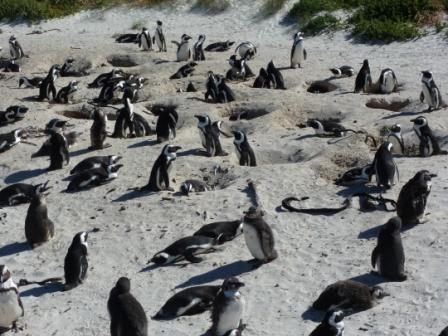
African Penguins nesting and resting on beach.
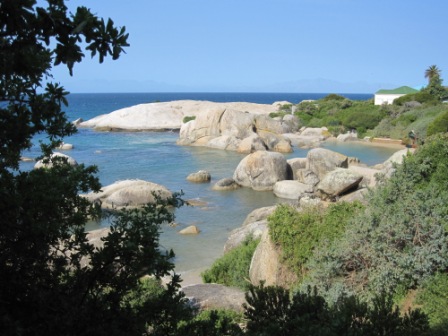
This is Boulders Beach, where people and penguins swim together in this lovely cove.
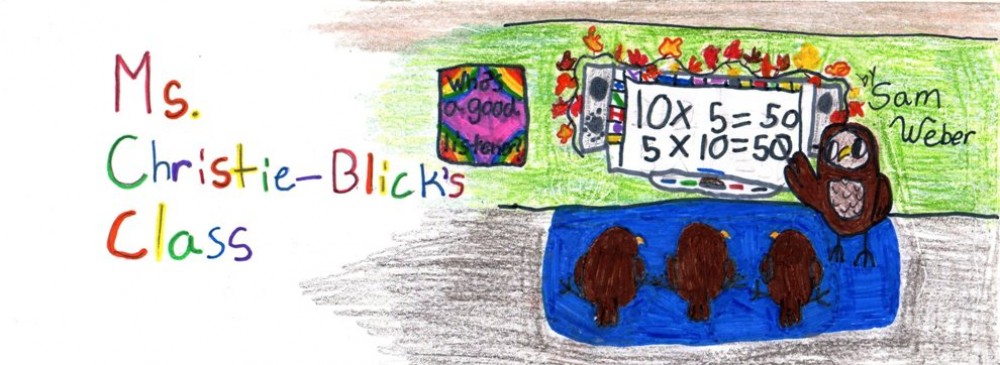
Have you seen any other species of penguins on your trip?
Have you seen any other species of penguins on your trip?
The South African Penguin is the only penguin species in this country.
I love penguins soo much!
I love penguins soo much!
What are the penguins trying to say to each other in the video?
What do YOU think? We can only guess looking at their body language and how they respond to each other. There’s a field of science that deals with animal interactions. It’s called sociobiology. I think you’d find it fascinating, Liam.
Those penguins are so cute!!!!!! What kind are they? They are so AWESOME!
Those penguins are so cute!!!!!! What kind are they? They are so AWESOME!
They’re South African penguins.
Wow! I never knew that a spieces of penguins lived in Southern Africa.
I just want to hug one of those penguins.
Hope you are having a good time down there.
Wow! I never knew that a spieces of penguins lived in Southern Africa.
I just want to hug one of those penguins.
Hope you are having a good time down there.
The penguins are so cute. Who would of amagined penuins in south africa. i would love to see one in person.
The penguins are so cute. Who would of amagined penuins in south africa. i would love to see one in person.
The penguins look so cute. there is one that is so loud it hurt my ears. i would love to see one in realy life.
The penguins look so cute. there is one that is so loud it hurt my ears. i would love to see one in realy life.
What types of penguins live in Africa? Do they have different physical features do the penguins in South Africa have than the ones in Antarctica? What different adaptations do they have?
Here is a really interesting site on the South African Penguin and other penguin species:
http://www.arkive.org/african-penguin/spheniscus-demersus/
After viewing this site, and my blog page, see if YOU can tell ME the answers to your questions!
What types of penguins live in Africa? Do they have different physical features do the penguins in South Africa have than the ones in Antarctica? What different adaptations do they have?
They are so cute! I have a question Mrs.Christie-Blick… How can you tell the difference between a male and a female penguin?Is it the size? Is it the looks? Hope you are having a fun time in South Africa!
They are so cute! I have a question Mrs.Christie-Blick… How can you tell the difference between a male and a female penguin?Is it the size? Is it the looks? Hope you are having a fun time in South Africa!
The male and female penguins look almost identical, Michele. The male is just a little bit larger. I’ve also heard that the male’s beak is a bit longer than the female’s, but it’s difficult for me to really see the difference.
Did most of your spotings of penguins happen in mostly one place.
Yes, they come ashore in just a few places in South Africa. I’m fortunate to live close to one of their favorite spots. I visit them almost every week! It’s very interesting to see the change in their behavior as the seasons change. Now in March, there are many more onshore. It’s nesting season. Last week there were hundreds on the beach!
Did most of your spotings of penguins happen in mostly one place.
Yes, they come ashore in just a few places in South Africa. I’m fortunate to live close to one of their favorite spots. I visit them almost every week! It’s very interesting to see the change in their behavior as the seasons change. Now in March, there are many more onshore. It’s nesting season. Last week there were hundreds on the beach!
Are penguins your favorite animal? What other animals did you see? Which animal was your favorite?
Yes, penguins are definitely a favorite! I’ve also seen guinea fowl and ostriches in the wild. These are all lovely looking, fascinating birds. Thinking about mammals, I’ve seen wild baboons, mongooses, hyraxes, and whales. It is so very exciting to see animals in the wild, just doing their own thing, acting naturally!
Did you see any turtles? Turtles and Penguins are my favorite animals!!!!!
I’ve seen tortoises. See the video on the Birds of a Feather post.
Where do the penguins get there water? 🙂
If you re-read this blog post, I bet you’ll find the answer.
that is so cool
Do the penguins get sunburned like the hippos?
Interesting thought, Michael. I think not, because their feathers protect their skin.
Why do some penguins come up to even South America? I thought they only lived in Antarctica
You’re right. There are penguins in South America too. I’ve never seen them, but I know there are some that live in Chile and Argentina. In addition to the African Penguin here in South Africa, I’ve also seen penguins in New Zealand and Australia. I came across a really good website I think you’ll like: http://www.siec.k12.in.us/west/proj/penguins/main.html
It has lots of interesting information about different penguins and where they live, alsong with some great pictures. Give it a try!
Why do some penguins come up to even South America? I thought they only lived in Antarctica